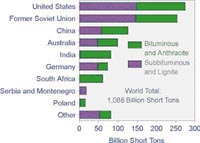 |
 |
Climate Change · Part One Climate Change · Part Two Climate Change 2 Syllabus 1.0 - The Ice Ages: An Introduction 2.0 - Discovery of the Ice Ages 3.0 - Ice Age Climate Cycles 4.0 - Climate Through the Last 1000 Years 5.0 - Determining Past Climates 6.0 - Causes of Millennial-Scale Change 7.0 - Climate and CO2 in the Atmosphere 8.0 - Recent Global Warming 9.0 - Climate Change in the Political Realm 10.0 - The Link to the Ozone Problem 11.0 Future Energy Use · 11.1 - Attempts to Guess the Future · 11.2 - Future Use of Fossil Fuels · 11.3 - The Future of Methane · 11.4 - The Future of Nitrous Oxide 12.0 - Outlook for the Future Introduction to Astronomy Life in the Universe Glossary: Climate Change Glossary: Astronomy Glossary: Life in Universe |
Future Use of Fossil Fuels Introduction
There are several questions that need to be answered regarding future energy use:
Although these suggestions may have merit, according to the U.S. Department of Energy statistics energy use in the U.S.A. is increasing steadily. From 1972 to 1996, U.S. energy use increased by 20 quadrillion Btus - a compound growth rate of about 1.0 percent per year. Thus, experience provides no support for the “saturation” hypothesis. It is equally likely that the demand for energy will keep increasing in the advanced countries as well as in the less developed ones. In addition, the population in the U.S. is still increasing quite rapidly, and every year there are around 4 million more people in the U.S. needing energy. Clearly, much additional demand will be generated by those countries that have the will and the means to increase the standard of living of their people. China and India are foremost in this category, with roughly one third of the population of the world. Even where this drive toward better standards of living is lacking in will or in means, the increase in the numbers of people will see to it that the demand for energy will keep on increasing rapidly. Energy Use and Emission Trading
There are two competitions going on between the nations of the world. One is for the use of the energy sources. The other one is for the use of the atmosphere as a receptacle for the waste generated by energy use. The first competition is regulated by the market: energy will be available to those who can pay for it. This makes it unlikely that the discrepancy in energy use between rich and poor will disappear soon. In fact, the reverse is just as likely. Higher energy use provides advantages in terms of wealth which will be used in the market to make sure that the necessary energy to drive the economy will be available. The second competition is not currently regulated. Whoever wishes to dump waste into the atmosphere can do so, with very few exceptions. A proposal to trade “emission rights,” made by US delegates to the Kyoto conference has been largely viewed with suspicion. On the surface, “emission trading” would seem simply an attempt to bring market-type regulation to emissions. Promoted by economists who believe in the power of the market forces to regulate behavior, the “emission trading” scheme determines each country’s emissions quota. Presumably, such trading would have the consequence that energy users would pay non-users for dumping waste (carbon dioxide) into the atmosphere. For example, a country that emits less than its quota (e.g., Russia) could sell its unused allotment to another country (e.g., the U.S.), which could then emit that much more than its assigned quota. Future Emissions and Energy Resources
The most efficient means to control future emissions is to raise the price of carbon-based energy. This is happening through the efforts of the Organization of Petroleum Exporting Countries (OPEC ; which attempts to keep prices high for the profit of producers), through the market (which balances demand and supply, by pricing) and, in European countries, through high taxation. (One reason there is less energy-use per capita in Europe than in North America is the high tax on gasoline. In turn, such taxes are available for building infrastructure and other services, like roads and mass transit. Such taxes also, by decreasing demand, have the effect of keeping prices down. The consumer pays an inflated price, but with the extra profit going to his government rather than to the supplier.) It has long been suggested that the reserves of petroleum are dwindling. Dwindling resources, according to economic principles, should result in higher prices and hence lower use. Thus, we might expect, as petroleum becomes scarce, emissions will be reduced.
In summary, the prospect is for increasing demand for energy in all countries. The most advanced countries might be able to make due with current use or less, through increased efficiency, or increased use of non-carbon energy. The industrializing countries (China, India, Brazil and many others) will press for increased use to allow expansion of their economies. Some of these countries, like China, have the resources to do so. Others will have to buy fuel in the world market. Their lack of means to pay will slow the expansion. The poor countries will continue to burn wood and deforestation also will continue. Thus, given the supplies of combustible fuel available, and the prospects for increasing demands for energy, there is no reason to expect that emissions will decrease. Stabilization of emissions (that is, no increase) might be hoped for but this would have to come about by decreasing emissions from the industrially advanced countries to make room for increased emissions from the countries trying to catch up. The incentives for cutting back on energy use in technologically advanced countries in favor of expanding the economies of potential competitors have yet to be defined. |
back to top |
| © 2002 All Rights Reserved - University of California, San Diego |
